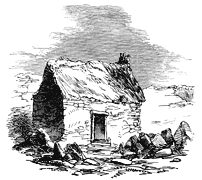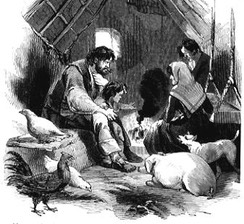The more substantial farms had good family houses; but the dwellings of the peasantry were extremely poor. Houses were made of clay or stone depending on the local soil condition.

Houses made of clay were predominant. These cabins were small usually two rooms with a thatched roof and one glass window.
The following description of housing was made in a report to the British government's Poor Inquiry:
The cabins were of stone, mud walls, or sods, as happens to be most convenient; seldom glazed or plastered; badly thatched; the floor of clay, which as well as the walls, is, for the greater part of the winter, wet with rain falling through the roof; the family sleeping on some dried rushes or straw thrown on the floor in the chimney-corner, as the warmest place in the house, with stones placed to keep the bed from taking fire: their own clothes thrown over them to assist the scanty bed clothes.
Even if there had been the financial means to do so, there was little incentive for the Irish to improve property or home. The land and house was owned by the protestant landlord and lease terms were at his whim. Improvements to the property or home would lead to a higher property assessment and thus an increase in the rent - a thing to be avoided.
For generations, families would have tried to maintain their lifestyle rather than improve it so as to deny the landlord a justification to raise rents. Protestant stereotypes of Catholic indolence and slothfulness were somewhat ironic since the protestant land system tended to encourage this behaviour in their Catholic tenants by withholding incentives and financial means to improve.
The cabin was furnished typically with straw as a bed, a few stools, sometimes a table, tins to drink from and a pot for cooking potatoes. But even these few items were not found in the poorest homes.

The "Poor Inquiry Reports" of the 1830s state that peasants were very poorly clad, some reports describing the clothes as rags. Clothing was made of a very coarse material, corduroy or homespun woollens. Men dressed in grey or occasionally blue. Local officials wishing to impress the British government reported better conditions; for example, that it was rare to see men or women without shoes and stockings. But other, more accurate accounts from both Catholic and Protestant clergy give a much bleaker picture.
The diet consisted almost entirely of oatmeal, milk, and potatoes. Potatoes were eaten daily in every household and at every meal. An adult would eat as much as 14lbs of potatoes per day. Buttermilk, oatmeal and even herring were sometimes available depending on the season of the year and the family's income.
The Dowd's may have also supplemented their diet with pike, eel and trout which were all found in the nearby lakes. However, the staple of potato and buttermilk was a nutritious meal and provided even the adult labourers with sufficient proteins and carbohydrates to sustain them. There was a downside to the potato crop. In a normal season potatoes from the annual harvest could only be stored for six months so most families were used to struggling through the last few weeks between harvests.
The Dowd "farm" or patch would have been small. At most, the family may have worked one to five acres, enough to sustain a family, along with the rights on an area of bog for the collection of peat - their main source of fuel. In the spring and summer the crops were cultivated and harvested.
The family would have owned a loom for weaving linen which was worked mostly in the fall and winter. Women spun and men weaved. The loom was an important source of income for many farmers, so much so that many neglected their land in order to increase their linen production. But by the 1830s this source of income was diminished as the linen industry failed in Ireland. To appease English manufacturing lobbyists in London, the government had imposed restrictions on the exporting of linen outside of Ireland. At the same time however, they left free the import of British goods into Ireland. This unfair trade practice, and industrialization in England, made it difficult for local products to compete and destroyed the Irish linen and other industries. The loss of this important income contributed further to the economic distress of Catholic families.
The Dowd family probably raised a pig as well, feeding it the potato and dairy scraps. With no separate housing, livestock were often kept in the house for shelter with the rest of the family. The pig was important for the household economy as one of the principal ways of paying rent.